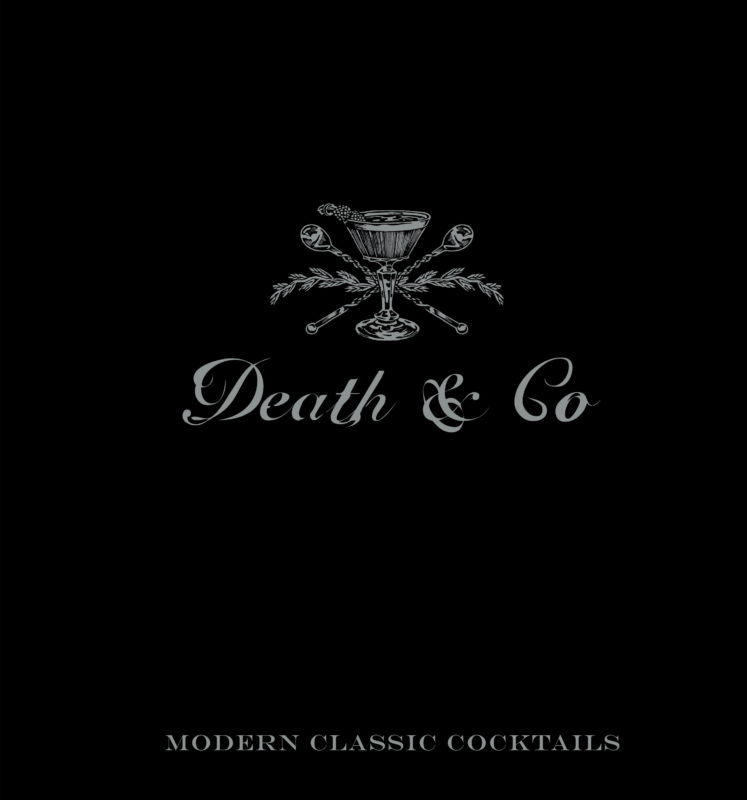


They show us how to resurrect classic cocktails, use new and innovative ingredients, test unique garnishes, tell bartenders’ stories, suggest useful techniques, and provide a glimpse into the history of cocktail culture.
With thousands of options, choosing what to read might seem daunting. To help you out, our team of bartenders, bar managers, homebrewers, and cocktail enthusiasts has curated a list of our favorites. Here are 8 essential cocktail books for bartenders.

As a bartender, you’ve probably heard of Death & Co. Since opening in Manhattan’s East Village on New Year’s Eve in 2006, they’ve received worldwide recognition and won awards like the Tales of the Cocktail Spirited Awards for Best American Cocktail Bar and World’s Best Cocktail Menu. Their staff is considered to be some of the best in the industry, and they’ve created some of today’s most iconic cocktails like the Naked and Famous, the Conference, and the Oaxaca Old Fashioned (a few of which we made and tasted ourselves).
In October of 2014, David Kaplan, Nick Fauchald, and Alex Day released their book Death & Co: Modern Classic Cocktails. Designed to be the definitive reference on craft cocktails, it includes over 500 ingenious and trendy drinks from behind the bar at Death & Co and discusses the philosophy of drink making. It also gives suggestions for buying and using spirits, and it teaches key bartending techniques.
BevSpot’s Director of Product Management, Chris Zegel, says he’s read Death & Co cover-to-cover, several times. Needless to say, he highly recommends it.
“It’s much more of a recipe book with some history on cocktail revival thrown in.”
“They have their own recipes for the classics and they explain where those were sourced/adapted from, along with all of their signature drinks, broken out by primary spirit and type (generally shaken/stirred for each category). With this organization, it’s really easy to say, ‘Hmm, I want a stirred gin drink tonight’ and pull out the book to find something.”
“As far as recipes go, there are a good number of drinks you can assemble without hunting down too many weird ingredients, minus some of the rums (I just don’t keep eight different kinds of rum at home… even though I probably should, given how many great tiki recipes I’m seeing lately). I also enjoy how the authors note each drink’s origin and credit each recipe to a certain bartender. Since the book lists the names of the bartenders, I’ve been able to follow them as they’ve gone on to other projects and to open new places.”
“I’ll end with a funny story: After I absorbed the whole book, I showed up at Death & Co one night after taking the train to New York City for a day of business meetings. I proceeded to order a Negroni and, dead sober, immediately spilled it directly into the ice bucket. I almost walked right back out of there in shame, but they were super cool about it.”
In Dave Arnold’s world, it’s all about the details. The shape of the ice cube, the bubbles in champagne, and the sugars and acids in an apple are carefully measured, tested, and teased. At Booker & Dax, New York City’s high-tech bar, Arnold and his team dive into carbonation, acidity, sugar concentration, and temperature to find ways to advance classic cocktails and design new ones. In his book, Liquid Intelligence: The Art and Science of the Perfect Cocktail, Arnold pushes readers to change their expectations about what a drink should look and taste like.
The book features 120 recipes, but it’s primarily a technique book that focuses on applying principles of science to the art of mixing drinks. Arnold expands the boundaries of traditional craft with chapters that focus on applications of a centrifuge, liquid nitrogen, and gellan washing. You can easily find yourself spending two hours reading about ice (and loving every minute of it) or deeply involved in the process of clarifying cloudy lime juice with enzymes. In addition to this cutting edge scientific approach, Arnold offers practical tips for tasks, such as making your own soda and preparing cocktails by the pitcher.
Last year, the critically acclaimed bar, The Dead Rabbit Grocery & Grog, released its first cocktail book and the world stood still. Well, not really, but people were pretty damn excited.
Even if you haven’t had the chance to visit, the name probably sounds familiar. In just the past year alone, The Dead Rabbit was awarded the World’s Best Bar and World’s Best Cocktail Menu by the Tales of the Cocktail Spirited Awards. The book, written by Sean Muldoon, Jack McGarry, and Ben Schaffer, offers historic and innovative drink recipes, has an entire chapter on absinthe, and includes recipes for large-batch punches. It also captivates its readers with the inspiring story of Dead Rabbit’s Founder, Sean Muldoon, and Bar Manager, Jack McGarry that started in Ireland and lead them to the peak of the cocktail world.
If you’re looking to experiment with modern takes on historical drinks, you won’t be able to put this one down. By the time you’re done, post-it notes will be sticking out of various pages, marking the drinks you can’t wait to make. We’ve already reviewed some of their best creations.
Like a good drink? Like American history? Imbibe! should be right up your alley. This spirited, historical, and clear-cut guide to American cocktails includes the recipes and origins of hundreds of essential 19th century American drinks. The book’s author, David Wondrich, also pays tribute to Jerry Thomas, the first “celebrity” bartender, and reveals never-before-published specifics and stories of his life. If you appreciate the ageless appeal of a well-made cocktail and the unique American history behind it, this book is a must-read.
One of BevSpot’s Customer Success Managers, Trevor Driscoll, has a passion for mixing up cocktails at home. He’s read plenty of cocktail books, but he considers Imbibe! to be one of the best.
“Imbibe! is more than a book with drink recipes, it’s a gateway into the history behind them.”
“David Wondrich’s cocktail knowledge is head and shoulders above anyone else, and it shows. This book will help you piece together the stories behind all the drinks you already love, while at the same time give you a firm foundation to stand on when discovering new ones.”
The Savoy Hotel, located in the center of London, opened in 1889. It was the first luxury hotel in Britain, with electric lights, electric lifts, hot and cold running water, and bathrooms in most of the lavishly furnished rooms. Today, it’s still considered London’s most famous hotel.
Well-known bartender, Harry Craddock of The Savoy Hotel, first published his cocktail book in 1930. Craddock was born in England and moved to the United States when he was a young man. He worked in Cleveland and Chicago before moving to New York City to serve drinks at a number of famous bars, including Holland House and Knickerbocker. When Prohibition hit, Craddock, like many American bartenders, left for Europe. Once he landed in London, he went back to bartending, and in 1925 he became the head bartender at The American Bar at The Savoy Hotel. Before Craddock’s arrival, the American style of mixology wasn’t prominent in London. But, after his start at the American Bar, he quickly became famous for his unique style.
Since its creation, The Savoy Cocktail Book has been reprinted five times, and in 1999 was expanded to include some of The Savoy Hotel’s more recent cocktails. It includes over 750 recipes and covers cocktail creation, presentation, and consumption. It’s a great resource if you’re looking to recreate historic cocktails and revive the elegant style of the times.
Published in 1862, this book was the first ever cocktail book published in the United States. Jerry Thomas, who is considered “the father of American mixology,” lists standard cocktail recipes like sours, highballs, and fizzes. He also includes his own concoctions like his trademark drink, The Blue Blazer. Along with drink recipes, Thomas gives instructions on using a variety of bar tools. As a bartender, this classic is a must-read. Not only is it informative, it marks the tipping point where cocktail recipes transitioned from oral tradition to written recipes.
Do you know what plant bourbon originates from? What about sake? In a fascinating mixture of history, biology, chemistry, and mixology, Amy Stewart explores the plant origins of alcohol. Her book takes you through the flowers, trees, fruits, herbs, and fungi that humans have converted into alcohol over the centuries. You might know where some alcohol derives from, but in the pages of Stewart’s book, you’re bound to discover some curious, obscure, and even ancient plants that you never knew could be distilled and fermented into alcohol. With over fifty recipes and tips for gardeners looking to grow their own ingredients, this book will significantly expand your alcohol knowledge.
BevSpot’s Director of Marketing, Chris Kiertz, keeps a copy of The Drunken Botanist on his desk.
“Before I read The Drunken Botanist, I loved cocktails. I still love cocktails, but now my cocktails have context.”
“It’s like that botany class I never paid attention to…except it’s about booze. I used to cower in fear when I looked at a drink menu. But now, I’m having conversations with the bartender about the relationship between cochineal insect dye and Campari.”
“In all seriousness, The Drunken Botanist is an essential resource for those trying to up the ante on their beverage knowledge. Personally, I’m fascinated by the fact that everything we drink in some way derives from plants, and I’ve learned a new appreciation for these complex processes. I, for one, will never take my cocktails for granted again!”
This book is essentially a cookbook for cocktails. It includes 500 recipes, including both classics and unique originals. In addition to being a great resource for cocktails, the book’s author, Dale DeGroff—who is acknowledged as the world’s premier mixologist—shares information that he uses in his bartending training seminars. In addition to making distinctions between bourbon, rye, Irish and Tennessee whiskey, the book includes rich anecdotes from DeGroff’s many years behind the bar, drink history, and practical tips and techniques for using tools correctly and setting up and stocking the bar. Whether you’re a professional bartender or a novice, this book is must-read.
Cocktail books teach us new techniques, explain how to get the most out of ingredients, tell the history of alcohol and drinking culture, and provide recipes for both new and classic cocktails. We hope our list provides you with some solid reading suggestions!
Want to see some more visual cocktail recipes? Head to our crafting cocktails page.
Schedule 15mins to chat with a product specialist
Start a FREE Trial Today! BevSpot offers full product education and account setup for all customers! No card Information needed!
